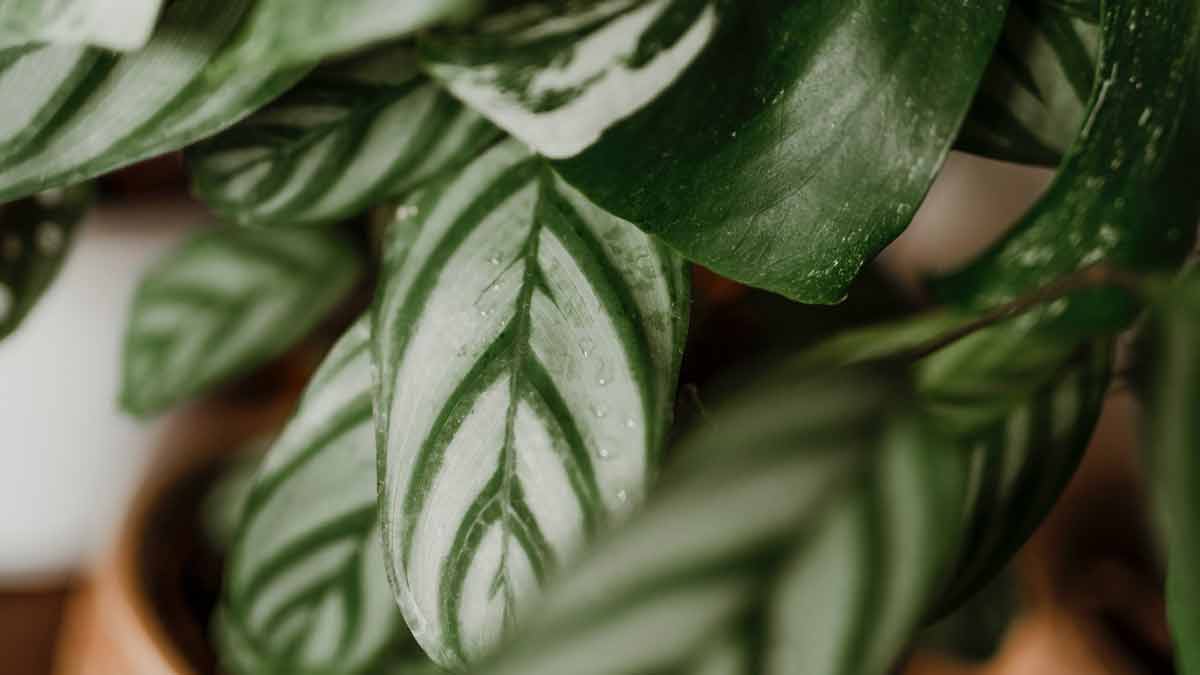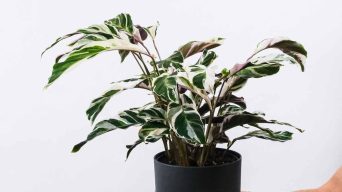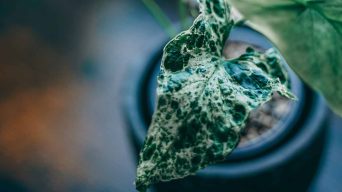Calathea plants, commonly known as the prayer plant, are known for their beautiful foliage, vibrant colors, and unique patterns. But overwatering can cause severe problems for these delicate houseplants.
If your Calathea is overwatered, you’ll quickly notice signs of distress, such as wilting leaves, yellowing or brown spots on the leaves, and root rot.
Fortunately, you can take steps to identify overwatering in your Calathea plant, treat it effectively and prevent it from happening again.
This article will discuss recognizing an overwatered Calathea plant and what to do if you find yourself in this situation.
How Does Overwatering a Calathea Occur?
There are several ways overwatering can occur when caring for a calathea plant. The most common causes of overwatering are:
Watering Too Frequently
Calathea plants prefer soil that is lightly moist but not soggy. If you water too frequently, the soil can quickly become waterlogged, leading to root rot and other issues.
It’s essential to check the soil moisture of your calathea regularly. Stick your finger into the soil; if it feels dry and powdery, it’s time to water. If moisture is present in the top inch of soil, wait a few days before watering again.
Calathea plants should be watered about once a week, depending on the environment and season. During the warmer months, the soil will dry out more quickly and may need to be watered every five to seven days.
Using The Wrong Potting Soil
Calathea plants prefer a potting soil that drains quickly and reduces the risk of overwatering. Look for a soil mix with perlite, vermiculite, or sharp sand. This will help keep the root system well-aerated while providing the necessary nutrients.
Avoid soil mixes containing peat moss or coco coir, as these materials retain more moisture. This can lead to overwatering and root rot over time.
Improper Water Quality
When watering your calathea, be sure to use filtered or distilled water. Tap water often contains chemicals like fluoride and chlorine that can damage the delicate calathea leaves.
These chemicals can also accumulate in the soil and cause overwatering issues. Using distilled or filtered water is inexpensive to ensure optimal health for your calathea plant.
You should flush your calathea’s soil with fresh water every two or three months to help remove any mineral buildup that could occur from hard water.
Pot Size
The size of the pot you house your calathea in can also have a significant impact on overwatering. If your calathea is in too small of a pot, it will be challenging to water properly and efficiently.
It’s important to use a slightly larger container than your calathea plant. This will provide enough space for the roots and soil to drain effectively.
Poor Drainage
If you’re using the right soil mix and pot size, overwatering can still occur if your pot doesn’t have proper drainage. Make sure there are several holes in the bottom of your container and that it sits on a surface that allows for good drainage.
Using a saucer underneath your pot can also help prevent overwatering. The saucer will catch any excess water and allow it to drain away from the pot.
What Does an Overwatered Calathea Look Like?
The signs of overwatering in calathea plants are often subtle, but they can be easy to spot if you know what to look for.
The most common signs of overwatering are:
Drooping Leaves
Calathea leaves may start to droop and wilt if overwatered. This happens when the plant can’t absorb enough water from its roots, so it instead draws on the moisture in its leaves.
Although overwatering can cause wilting and drooping, it can also be caused by underwatering or nutrient deficiencies. It’s important to look for other overwatering signs before coming to conclusions.
Yellow Leaves
Calathea plants are known for their stunning, brightly-colored foliage, so overwatered calatheas can be very concerning when the leaves start to yellow.
Excessive watering often leads to the presence of yellow leaves on calathea plants. Too much moisture in the soil will cause root rot, leaving the plant unable to absorb the nutrients it needs. As a result, the beautiful leaves turn yellow or brown and can eventually fall off the plant.
Brown Spots
In addition to yellow leaves, overwatered calathea plants may also develop brown spots on their foliage.
Brown spots are often caused by overwatering and lack of air circulation around the leaves. This can eventually lead to fungal infection or pests like spider mites, further damaging the plant’s health.
Curling Leaves
Another sign of overwatering is when the calathea leaves curl up. This can happen when the leaves lack moisture.
When overwatered, the plant will draw up more water than it needs, causing an imbalance in its system. This leads to curled and wilted leaves that are soft to the touch.
Soft and Mushy Stems
Soft, mushy stems are one of the clearest signs of overwatering.
When overwatered, the plant’s roots can become waterlogged and unable to absorb oxygen. This will cause the stems to become soft, squishy, and weak.
If left unchecked, it can lead to root rot and other diseases that can kill the plant.
Mold and Mildew
Overwatered calathea plants are also prone to mold and mildew growth.
Mold and mildew can be caused by overwatering, as it creates an environment that encourages these fungal organisms to thrive. If the soil is overwatered for an extended period, mold and mildew can form. They will appear as dark spots on the leaves or fuzzy patches on the soil surface.
It is vital to take action if you see signs of mold or mildew because it can quickly spread throughout your plant, causing further damage.
Root Rot
Overwatering is the primary cause of root rot on Calathea plants, resulting in its most severe consequences.
Root rot occurs when the roots are submerged in water for too long, preventing them from getting enough oxygen. The roots will begin to die off and turn brown or black. In severe cases, the plant may become completely stunted or die altogether.
Healthy roots should be white or cream-colored, so check your plant’s roots regularly to ensure they are in good condition.
Soggy And Smelly Soil
When overwatered, the soil may become soggy and start to smell. This is usually caused by anaerobic bacteria that thrive in waterlogged soils.
Bacteria and fungi feed off the nutrients in the soil, causing a foul odor. If you notice an unpleasant smell coming from your Calathea’s soil, it is likely overwatered and needs to be addressed.
How To Save an Overwatered Calathea
If you have overwatered your calathea (Calathea spp.) plant and it is starting to show signs of distress, don’t panic. You can take several steps to help save your overwatered calathea and get it back on track.
The following steps will help you nurse your overwatered calathea back to health:
Stop Watering Your Calathea
The first step is to stop overwatering your calathea. If you’ve been overwatering the plant, it will not recover until you properly adjust your watering schedule.
Allow the soil to dry out completely before you water again, and resist the temptation to give your calathea more water before it’s needed.
The best way to determine whether your overwatered calathea needs more water is by feeling the soil. If it’s still damp, wait until it has dried out before watering again.
Check for Root Rot
Root rot is a common problem with overwatered calathea plants. Root rot occurs when the plant’s roots are constantly exposed to moisture and start to break down, leaving them unable to absorb water and nutrients.
You can check for root rot by gently removing the plant from its pot. If you find brown, mushy, or black roots, there’s a good chance your overwatered calathea has root rot.
If you find evidence of root rot, it’s best to prune away the affected parts of the roots carefully. This can help encourage new growth and prevent further decay.
Repot Your Calathea
Once you have identified and removed any root rot, it’s time to repot your overwatered calathea.
Choose a pot slightly larger than the previous one and fill it with fresh soil. Gently transfer your overwatered calathea into the new pot, making sure to spread out the roots.
Don’t water your calathea immediately after repotting. Allow the soil to dry out completely before you begin watering again.
Prune Damaged and Dead Leaves
Once your calathea has been repotted, you’ll want to prune away any dead or damaged leaves.
Removing these leaves helps encourage the plant to focus its energy on producing healthy new growth. Pruning will also help reduce the risk of further infections and decay.
Cut calatheas leaves at their base, ensuring not to damage the healthy parts of the plant.
Also, clean your pruning tool before and after you use it, as this will reduce the risk of spreading disease.
Place in a Bright, Warm Spot
Once you’ve finished pruning your calathea, it’s time to find the perfect spot for it.
Place your calathea in a warm and bright area to encourage healthy new growth. Make sure the temperature doesn’t drop below 55°F (14°C).
Your plant will also benefit from some indirect sunlight. So, giving your calathea a few hours of bright, indirect light each day will help it heal and grow stronger.
When growing calathea plants indoors, the best way to provide indirect light is by placing them near a bright window. East- or west-facing windows are ideal, as these will provide the plant with plenty of bright light without direct sunlight.
Water With Care
Once you’ve repotted your calathea and placed it in a suitable spot, it’s time to start watering again. Be careful not to overwater your calathea — this could cause root rot and other damage to the plant.
Water your calathea when the surface of the soil feels dry to the touch, and water until it drips out of the pot’s bottom. Then, empty any excess water from the saucer, so your calathea isn’t in soggy soil.
How To Prevent Overwatering Calathea Plants
Overwatering can be a severe issue for calathea plants. If they are overwatered, the roots can become rot, and the leaves will start to yellow and drop off.
To avoid this, it is essential to water your calathea plants correctly. Here are some tips on how to prevent overwatering:
- Use well-draining soil. To help prevent overwatering, it is essential to use a soil that allows excess water to escape. A good option is a potting mix with perlite or vermiculite in it.
- Check soil moisture. You should always check the soil before you water your calathea plant. Stick your finger into the soil up to the first knuckle; if it feels moist, water is not needed. If it feels dry, then you can water the plant.
- Water sparingly. When you water your calathea plant, ensure you only use enough to moisten the soil without making it soggy. This will help prevent overwatering and ensure that the roots have access to oxygen.
- Use a pot with drainage holes. To prevent overwatering, it is important to use a pot with adequate drainage holes on the bottom. This will allow any excess water to escape and help keep your plant’s roots from becoming waterlogged.
- Consider using a terracotta pot. A terracotta (clay) pot can help with overwatering, as they are porous and allow excess water to evaporate.
- Use the right size of pot. The size of the pot is also important when it comes to avoiding overwatering. You should select a pot just one or two sizes larger than the root ball. This will help prevent the roots from becoming waterlogged and provide room for growth.
- Place the plant in a bright but shaded spot. Calathea plants prefer bright, indirect light. Placing your calathea in a too sunny area can cause the soil to dry out quickly, leading to overwatering.
- Use a water meter probe. A water meter probe is easy to measure soil moisture and ensures you are not overwatering your calathea plant. Insert the probe into the soil and read the results.
- Use the “soak and dry” method. The “soak and dry” method involves thoroughly soaking the soil before allowing it to dry out completely before watering again. This helps ensure your calathea plant isn’t sitting in soggy soil for too long, which can cause root rot.
- Be aware of changing seasons. During the winter, your calathea will require less water due to lower temperatures and reduced light levels. Increase the watering frequency in the summertime as the days become warmer and brighter.
These simple tips can help your calathea plant thrive and grow strong for many years. With the proper care and attention, you can prevent overwatering and enjoy beautiful foliage from your calathea all year long!
Final Thoughts
An overwatered plant can be a challenge to fix. Still, with the proper care and attention, it is possible to save your calathea.
It’s important to remember that signs of overwatering often look similar to those caused by underwatering or even plant diseases or pests.
Pay close attention to your plant and note any changes in its leaves, soil, and overall health. With patience and effort, you’ll be able to help your calathea thrive.
Also, remember that prevention is the best medicine for keeping your calathea healthy.
Make sure you understand the care needs of this particular plant species before bringing one home, then stick to a regular watering schedule that balances hydration and air circulation.
With the proper care, you’ll enjoy a thriving calathea for years.







